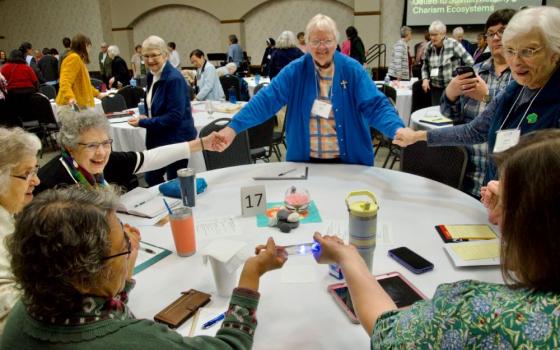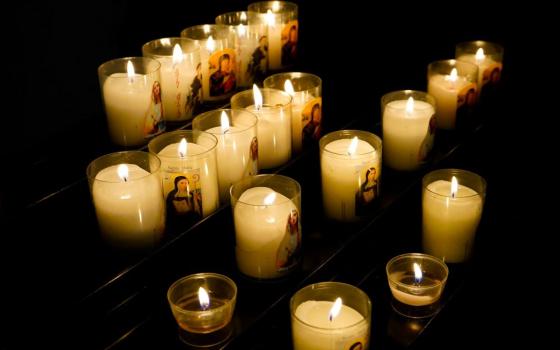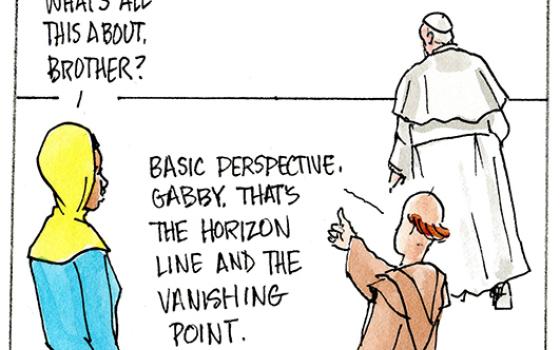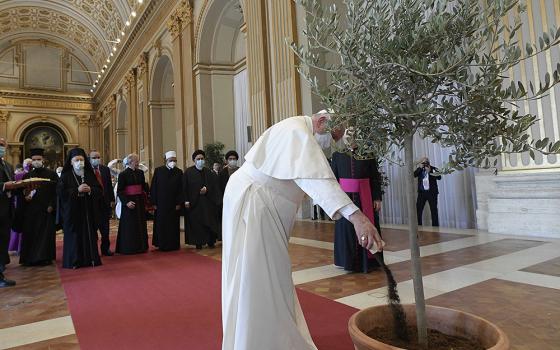
In the Matamoros camp on the Mexican side of the U.S. border, Esmeralda, a community leader from Honduras, pauses in wielding a pickaxe, digging a ditch to keep water runoff from her improvised kitchen from muddying the path below. She is one of thousands of refugees who have been forced to stay as a result of the so-called Migrant Protection Protocols, or "Remain in Mexico" policy. (GSR photo / Tracy L. Barnett)
"Alicia! Alicia!" Children's voices rang out and they crowded around as Notre Dame de Namur Sr. Mary Alice McCabe — or "Alicia," by her name in Spanish — made her way through the refugee tent camp in Matamoros, Mexico.
Children are everywhere in the camp, which has formed in the wake of the MPP — Migrant Protection Protocols, or "Remain in Mexico" policy. Enacted by the Trump administration beginning in January 2019, this is one of many harsh measures used to deter refugees, forcing them to remain in Mexico until their asylum claims are processed. Matamoros has an estimated 2,500 people in hundreds of small tents that stretch along the southern bank of the Rio Grande and atop the levee in front of the Gateway International Bridge in what has grown into a sprawling tent city on federal land, reluctantly tolerated by the Mexican government.
Matamoros, once a medical tourism and nightclub hotspot a quick walk from Brownsville, Texas, has been declared a no-travel zone by the U.S. State Department in the wake of high levels of cartel violence, along with the entire state of Tamaulipas. Yet the border region from Tijuana to Matamoros, much of it rife with kidnapping, rape and murder, is where more than 61,000 asylum seekers — most of them families with children — have been sent to wait, according to the Transactional Records Access Clearinghouse at Syracuse University.
McCabe makes her way through the camp, stopping to visit with friends she's made. Esmeralda, from Honduras, is wielding a pickaxe, digging a water diversion ditch to keep the runoff from her improvised kitchen from muddying the path below. As the wait stretches into months with multiple court hearings, families have made the best of the situation. They've formed work groups, bringing mud from the river to build adobe ovens and cane to build rustic furnishings. Smoke wafts up from dozens of kitchens, including the pop-up pupusería where McCabe often stops by for a chat and to order her favorite Salvadoran dish, a thick flatbread cooked with beans and cheese, and topped with grated vegetables.
After 40 years in Latin America — 35 in Brazil and five in Nicaragua — McCabe returned to the U.S. in 2015. Within a year, disturbed at the reports of unaccompanied minors at the border, family separations and other signs of the growing humanitarian crisis, she checked out the situation herself, and began volunteering as a translator.
She is one of more than 40 Sisters of Notre Dame de Namur, and more than 1,000 religious sisters in all, who have been volunteering at the border since late 2018, when the Leadership Council of Women Religious began putting out calls for help at the urging of frontline border responders, Missionaries of Jesus Sr. Norma Pimentel of Catholic Charities of the Rio Grande Valley among them. Sisters arrived from all over the country to lend a hand in the respite centers along the border that have served these incoming migrants for years.
Shift across the border
But as the MPP began in San Diego and rolled out over the year, the need shifted south of the border. In the Rio Grande Valley, it happened around the end of July, and McCabe and others began crossing over to help. McCabe typically goes to the border for four to five weeks, then returns to Baltimore to share what she's experienced. In her absence, Sr. Ellen Dabrieo, Sr. Betsy Flynn and others from her religious community take her place. GSR spent a week with McCabe in her rounds.
The first stop was to the Catholic Charities Humanitarian Respite Center in McAllen, Texas. At the height of the migrant arrivals in the summer of 2019, the agency was receiving up to 1,000 people a day, and Pimentel had procured a sprawling two-story complex across from the bus station to accommodate them, help locate their relatives in the U.S. and send them on their way.
Advertisement
When MPP was enacted, the flow diminished to a trickle of mostly African and Haitian refugees; on this day, she found a handful of Congolese refugees, and two Guatemalan women who had been allowed to cross because they were pregnant. McCabe visited with volunteers and staff, then went to Catholic Charities of the Rio Grande Valley headquarters in San Juan to meet with Pimentel for more context on the crisis.
Pimentel, an earnest, forceful woman with family on both sides of the border, began asking for help when a wave of unaccompanied minors from Central America began arriving in 2014. Since then, sisters have volunteered from San Diego to Matamoros, with the greatest surge in the past two years.
Sisters have provided legal, medical and educational support as well as responded to immediate needs, said Sr. Ann Scholz, a School Sister of Notre Dame and the associate director for mission for LCWR, the largest organization of leaders of women religious congregations in the United States. Congregations of women religious have contributed hundreds of thousands of dollars, as well. They have also lobbied for a more humane immigration policy, including an immediate end to the MPP.
Now under the MPP, Pimentel's role has shifted. She still coordinates donations of food and supplies, working with local civic and religious groups and government agencies to respond to the newest development in the crisis. Team Brownsville, for instance, provides meals in the camp twice a day, and Resource Center Matamoros provides space for legal and other types of assistance, networking with volunteers from all over. Sisters are part of those volunteer teams.

Witness at the Border maintains a vigil/protest against the MPP policy in Brownsville, Texas, across the street from the Gateway International Bridge; many Witness members take turns crossing over to volunteer. Notre Dame de Namur Sr. Mary Alice McCabe stops to visit with them on her way home at the end of her day. (GSR photo / Tracy L. Barnett)
Pimentel has been gratified at the sisters' response. "They have a chance to be on the right side of history, and that really speaks to what is happening today in our world," she said. "The sisters' presence makes a big difference with the care and compassion that they bring by being here."
From Brownsville into Mexico
McCabe is no stranger to poverty and violence. In Brazil, she'd worked with landless base Christian communities during the dictatorship in the 1970s and '80s, and accompanied many communities in their faith-based struggle for land rights, all through the 1990s and until the present.
She'd mourned the loss of her dear friend Sr. Dorothy Stang, a fellow Sister of Notre Dame de Namur, who was brutally murdered in 2005 for her defense of Brazil's Amazon and the region's impoverished farmers and indigenous. In Nicaragua, McCabe worked with women's agricultural co-ops from 1987 to 1992, during the end of the civil war.
Still, McCabe was shocked at what she saw in August 2019 when she crossed the bridge from Brownsville into Mexico, in the first weeks after the Trump administration began to implement the "Remain in Mexico" policy.
"A tent city was just beginning to form; there were three portable toilets for a thousand people," she recalled. "You could smell them a mile away. ... The children were covered with skin diseases from bathing in the river, because there was nowhere else. It was just horrendous."
Soon McCabe and her sisters were helping in a variety of ways, such as serving meals and translating for the medical professionals in Global Response Management's mobile clinic.
Thanks to the efforts of the asylum seekers themselves, in collaboration with volunteers, the encampment has taken on the feel of a rustic Central American village, with people chopping wood and cooking in their campsites, the children playing in the corridors or attending one of the small volunteer-run schools that have sprung up, some taught by immigrants themselves.

Sr. Mary Alice McCabe has struck up a friendship with Arsenio, the man with the baseball cap in the background, who is a Nicaraguan schoolteacher who has set up a small school in the camp under this tent. McCabe sometimes uses the tent to help asylum seekers with their "borradores," or draft I-589 applications for asylum. (GSR photo / Tracy L. Barnett)
The bulk of McCabe's time, however, is dedicated to the work of helping asylum seekers with their "borradores," or draft asylum applications. She was trained for this in 2016, when 12 Sisters of Notre Dame de Namur first responded to the border crisis, volunteering at the U.S. Immigration and Customs Enforcement family detention center in Dilley, Texas.
There, they worked with attorneys to help the women build their legal cases, to prepare for their credible fear interviews — the first step of the asylum process, when they must demonstrate a "credible fear" of returning to their home countries. This is a process that has become increasingly fraught with pitfalls, as it's not immediately clear what conditions qualify for asylum, and those have diminished dramatically since the beginning of the Trump administration.
Most recently, the administration is switching tactics again, phasing out MPP in favor of even more restrictive asylum policies and fast-tracking large numbers of asylum seekers to Guatemala, where they are told to apply for asylum there, instead of the U.S.
"At the time, we thought [the Dilley detention center] was horrible. Why are they putting women and children in jail? That's what our lawyers were saying; there should be no detention of these people," McCabe recalls.
Nevertheless, they had a relatively high acceptance rate for asylum, she said. "Now when we look back, anybody that was sent to that place was privileged; they had a good deal."
Asylum qualifications
These days, McCabe is still helping women and their children on their borradores, but now in tents along the Rio Grande. She sat in a smoky kitchen tent with Esmeralda as she cooked on her earthen oven. Esmeralda's son had worked as a debt collector for a business in Honduras, a country rated as one of the most dangerous in the world due to gang violence. Gang members spotted him and took all the money he carried. Soon it became a regular occurrence; he was threatened with violence if he resisted.
"He realized he couldn't make a living, and fortunately he got to the U.S. before the border closed," said McCabe. "Then they started coming after her and demanding to know the whereabouts of her son — and threatening to kill her if she didn't tell them. So she had to leave."
McCabe helped Esmeralda, as she does with many, to find the "nexus" in her case — the reason why she specifically was targeted. To qualify for asylum, one must meet the definition of a "refugee" — or have suffered persecution because of race, religion, nationality, membership in a particular social group, or political opinion. In this case, McCabe concluded, the social group that put Esmeralda at risk was her family. She worked for several days with Esmeralda, as she does with each family's case, to iron out all the details and fill out the draft forms in Spanish.
The stakes are often a matter of life and death; at least 138 Salvadorans have been killed in recent years after being deported back from the U.S., according to a recent report by Human Rights Watch. Countless Hondurans and Guatemalans have suffered similar fates.
Privately, McCabe worried that Esmeralda's chances were not good — seeing even stronger cases being rejected. So far, as of the end of January, only 263 — less than half of 1% — of the more than 61,000 sent back to wait in Mexico had been granted relief.
Another case she took on was that of Carmela, a Salvadoran mother of six. Threats of violence from members of the Mara Salvatrucha gang — who had entered her house while running from police and left behind a bag of marijuana, which she'd gotten rid of — led her to flee with her two youngest children.
In early December, Carmela joined the growing ranks of parents making the excruciating choice to send their children over the bridge alone. Unaccompanied minors have a better chance of acceptance for asylum, although the process is fraught with the risk of trauma and permanent separation.

Sr. Mary Alice McCabe usually takes several days to work with each asylum seeker on their legal cases, usually from within their own tents, or under the tarpaulins where they have set up their kitchens. (GSR photo / Tracy L. Barnett)
But Luis, 17, suffered from insulin-dependent diabetes and had run out. He proposed to take his 10-year-old sister and cross so he could ask for more medicine and then travel to New York to stay with Carmela's best friend from childhood, a legal permanent resident who had agreed to be their sponsor, while they waited for their mother. "I accepted — what else could I do?" she said.
At the time of McCabe's interview with Carmela in late January, she had confirmed that the children were together in Pennsylvania, in a detention center by day and with a foster family at night, far from her friend in New York. She had received a couple of calls from them through their caseworker, but was not able to call them. Sometimes as long as 11 days have passed without hearing from them.
Like most migrants McCabe interviews, Carmela is a devout Christian. Her eyes were moist but her head held high as she spoke. "I told them, 'Don't worry, hijos. God is good, and he can overcome this. Just trust in him. We will be together again."
An unprecedented 69,550 migrant children were held in custody in the U.S. over the past year, the AP reported in November. Inadequate government tracking systems have led to lengthy waits for reunification for thousands of families. Hundreds of parents have been deported without their children — all statistics that McCabe was aware of, though she said nothing to Carmela. Instead, she took down the friend's name and contact, as well as the caseworker's. "I'm going after them," she vowed.
'They live under tremendous tension'
The powerful mobilization of sisters in the recent crisis is consistent with the history of religious sisters in the U.S.
"We came as immigrants to serve immigrants, and we continue to serve immigrant populations in schools, hospitals and social service agencies," said Scholz. "Our response ... is not limited to six, or eight, or 10 months — it's a permanent commitment to the call of the Gospel to welcome the stranger and build God's beloved community."
McCabe is a keen observer of history as well, and she is particularly galled by the historic relationship between the U.S. and Latin America. She maintains that these people — who only want to provide safety and security for their families — are the victims of U.S. foreign policy that has destabilized the region for generations.
"Our muddy boot prints are all over Central America," she said.

Sr. Mary Alice helps with translation at a clinic at the Matamoros camp. Many of the residents suffer from illness and stress-related health issues. (GSR photo / Tracy L. Barnett)
On her last day at camp before returning to Baltimore, McCabe divided her time between translating at the mobile clinic, tying up loose ends on the asylum case of one mother of two, and saying her goodbyes.
At the medical clinic, the cases she saw were typically related to the poor living conditions: backaches from sleeping on the ground; respiratory problems from living in the cold, aggravated by the smoke and the dust; broken bones from falling on the slippery slopes when it rains; and abdominal pain from many sources, not the least of which is chronic anxiety.
"They live under tremendous tension because they don't know about their future; they have lived in fear for an enormous amount of time — some have lived in fear their whole lives, and it's not over yet," she reflected. "They know that the possibility is that they will be deported back to tremendous danger, maybe death — and the future they've dreamed of for their children will not be possible. I think they're up all night thinking about it, and the symptoms we're seeing — gastritis, severe headaches, muscle tension — are all tied in with that."
She weighed her words carefully, words that would later be shared with her congregation, with church groups, with the public she would address in hopes of mobilizing support for a change in government policy.
"These people are so noble," she said. "They believe that God will get them to the United States — but the organizing has to be on our part. This just has to stop. It's too evil, and it's killing people."
[Tracy L. Barnett is an independent writer, editor and photographer specializing in environmental issues, indigenous rights and sustainable travel, and the founder of The Esperanza Project, a magazine focusing on social change initiatives in the Americas.]














